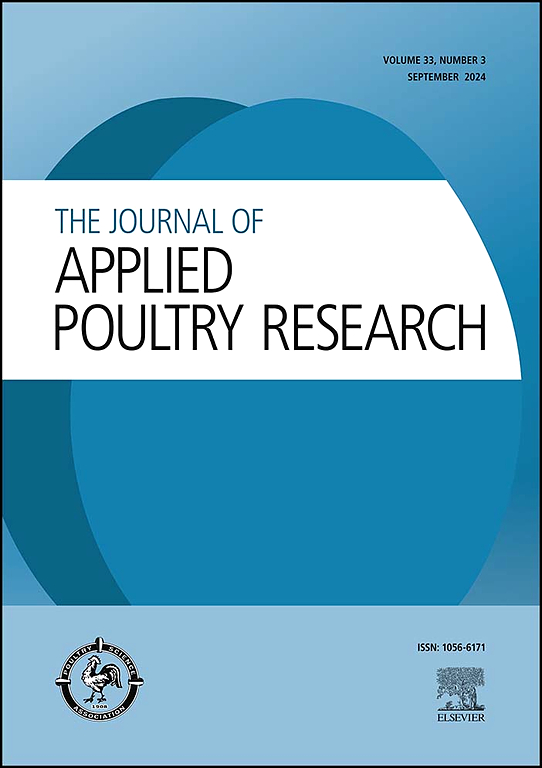饲养至8周龄的4个商品肉鸡品系雄性和雌性肉鸡的摄水量和水分转化率
IF 2
3区 农林科学
Q2 AGRICULTURE, DAIRY & ANIMAL SCIENCE
引用次数: 0
摘要
对肉鸡生产可持续性的兴趣和调查的增加导致需要可靠和可重复的方法来测量水分摄入量及其转化为可销售肉的速度。为此,对4个现代肉鸡品系的雄性和雌性肉仔鸡采食量和水分转化率进行了研究。其中2个品系代表瞄准小型鸟类市场的快速生长肉鸡品系(FGB A和FGB B), 2个品系代表高产肉鸡品系(HYB A和HYB)。选取3个重复,每个品系25只肉鸡,放入24个试验栏中,饲养8周。每周监测肉仔鸡体重、采食量和采水量,计算料重比和体重比。分别在6周龄和8周龄对肉鸡进行加工,测定胴体性状。在整个试验期间,雄性肉鸡的饮水量均较高。在整个试验期间,菌株显著影响了肉仔鸡的采水量和体重比,但这些差异似乎与肉仔鸡的产品类型(即快速生长或高产)无关。从第4周开始,一直持续到第7周,观察品系和性别在饮水量方面的相互作用。品系和性别之间没有相互作用。本文报告的采食量数据和WCR可用于参考文献和未来研究中为肉鸡行业的两个主要部门提供的肉鸡基线值。本文章由计算机程序翻译,如有差异,请以英文原文为准。
Characterization of water intake and water conversion ratio for male and female broilers from four commercial broiler lines reared to eight weeks of age
Increased interest and investigation into the sustainability of broiler production has led to a need for reliable and repeatable means to measure water intake and its conversion rate into salable meat. Therefore, a study was conducted to characterize the water intake and water conversion ratio (WCR) of male and female broilers from four modern broiler strains. Two of these lines represented fast growing broiler strains (FGB A and FGB B) targeting a small bird market and two represented high yielding broiler strains (HYB A and HYB B). Three replicates of 25 sexed broilers from each line were placed into 24 experimental pens and reared for an 8-week period. Broiler BW, feed intake, and water intake were monitored weekly and used to calculate feed conversion ratio (FCR) and WCR. Broilers were processed at 6 and 8 weeks of age for determination of carcass traits. Male broilers had higher water intakes throughout the experimental period. Strain significantly influenced broiler water intake and WCR throughout the experimental period, but these differences did not appear to be linked to broiler product type (i.e., fast growing or high yielding). Interactions between strain and sex were observed for water intake starting at week 4 and continuing through week 7. No interactions between strain and sex were observed for WCR. Water intake data and WCR reported herein serve to allow for baseline values derived from broilers serving the 2 major sectors of the broiler industry in literature and for future research.
求助全文
通过发布文献求助,成功后即可免费获取论文全文。
去求助
来源期刊

Journal of Applied Poultry Research
农林科学-奶制品与动物科学
CiteScore
4.10
自引率
10.50%
发文量
80
审稿时长
104 days
期刊介绍:
The Journal of Applied Poultry Research (JAPR) publishes original research reports, field reports, and reviews on breeding, hatching, health and disease, layer management, meat bird processing and products, meat bird management, microbiology, food safety, nutrition, environment, sanitation, welfare, and economics. As of January 2020, JAPR will become an Open Access journal with no subscription charges, meaning authors who publish here can make their research immediately, permanently, and freely accessible worldwide while retaining copyright to their work. Papers submitted for publication after October 1, 2019 will be published as Open Access papers.
The readers of JAPR are in education, extension, industry, and government, including research, teaching, administration, veterinary medicine, management, production, quality assurance, product development, and technical services. Nutritionists, breeder flock supervisors, production managers, microbiologists, laboratory personnel, food safety and sanitation managers, poultry processing managers, feed manufacturers, and egg producers use JAPR to keep up with current applied poultry research.
 求助内容:
求助内容: 应助结果提醒方式:
应助结果提醒方式:


